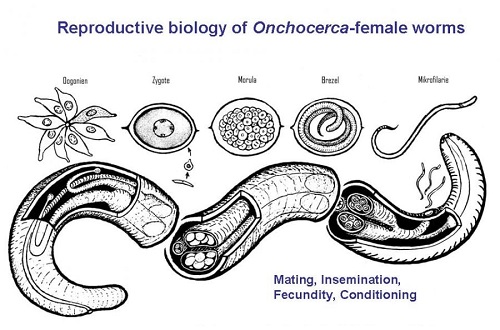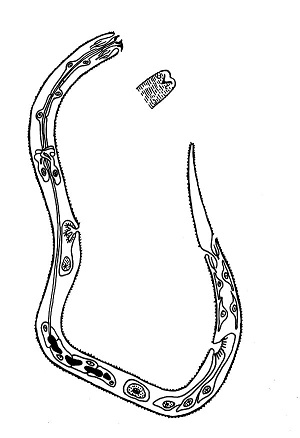Onchocerca volvulus - Introduction, Classification, History, Habitat, Morphology
Introduction to Onchocerca volvulus
Onchocerca volvulus is a filarial nematode and the etiological agent of onchocerciasis i.e. river blindness. The arthropod-borne roundworm parasite is the second leading cause of blindness due to infection worldwide, the first being trachoma.
The parasite obtains nutrients from the host by ingesting blood or by diffusion through its cuticle.
It is possible that they are able to trigger blood-vessel formation since dense vascular networks are often found surrounding the fibrous nodules where worms habitats.
Classification of Onchocerca volvulus
The classification of Onchocerca volvulus is done as:
Kingdom: Animalia
Phylum: Nematoda
Class: Chromadorea
Order: Rhabditida
Family: Onchocercidae
Genus: Onchocerca
Species: O. volvulus
History of Onchocerca volvulus
Historically, Onchocerca volvulus was first described by Irish surgeon John O’Neill in 1874. He had discovered the parasite to be the causative agent of a skin disease found in West Africa called ‘craw-craw.’
In 1915, Guatemalan doctor Rodolfo Robles demonstrated the worm on the Pacific slopes of Guatemala and linked it to visual impairment in 1917. French parasitologist Émile Brumpt in 1919 named the nematode Onchocerca volvulus and D. B. Blacklock in 1926 first identified the female black fly (Simulium) as the vector responsible for the parasite transmission.
Habitat of Onchocerca volvulus
Adult Onchocerca volvulus habitats the nodules in the subcutaneous tissue (dermis layer) of its infected human host. The parasite remains tightly coiled within the nodule. The microfilariae of Onchocerca volvulus are found in the skin while they are absent from the host blood.
Morphology of Onchocerca volvulus
Significant morphological stages of Onchocerca volvulus include adult worms, microfilaria, and infective larvae.
Adult worms
adult worms of Onchocerca volvulus are white, opalescent, transparent
have transverse striations on the cuticula – a distinguishing feature
coiled together in the subcutaneous nodule – of same or different sex
curved tail or posterior end
dioecious species – distinct male and female
release of oocytes (eggs) in female worms is independent of the presence or absence of male Onchocerca volvulus
male may be attracted to fertile females by the action of unidentified pheromones
life-span of over 10 to 15 years in the human host
host immune response is only induced following the parasite’s death and degradation

Onchocerca volvulus adult female morphology (Source: riverblindness.eu)
Male
male Onchocerca volvulus measures 19 to 42 cm in length and 0.13 to 0.21 mm in diameter
curved, bulbous with two asymmetrical spicules of unequal length
freely moves around subcutaneous tissue
Female
female Onchocerca volvulus measures 33.5 to 50 cm in length and 0.27 to 0.4 mm in breadth
a vulva opening is situated behind the posterior extremity of the esophagus
a mature female can produce between 500 and 1,500 microfilariae per day
permanently resides in fibrous nodules
Microfilariae
microfilariae of Onchocerca volvulus are found in the skin
smaller in size when compared to Wuchereria bancrofti and Brugia malayi
measures 240 to 360 µm in length and 5 to 9 µm in breadth
nuclei absent from both the anterior end and posterior end
pointed tail and slightly enlarged anterior end
lacks sheath i.e. when they mature, they exit from the envelope of the egg
only found in the skin – absent from host blood
life-span of 1.0 to 1.5 years
no immune response if present in the bloodstream
host immune response is only induced following the parasite’s death and degradation

Onchocerca volvulus microfilariae morphology (Source: riverblindness.eu)
Infective larvae
infective larvae of Onchocerca volvulus are found in the mouthparts of the arthropod vector, the female black fly (Simulium)
measures 100 µm in length